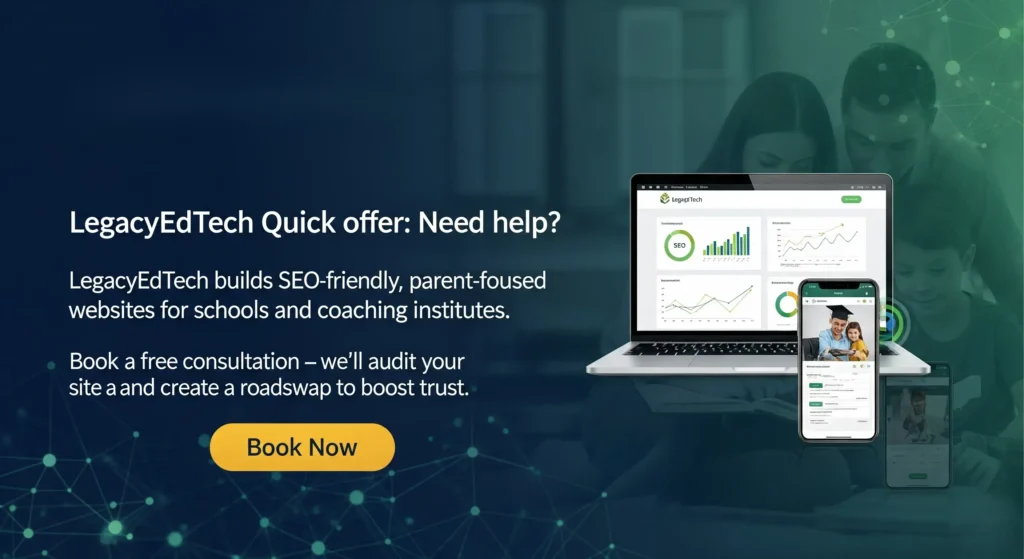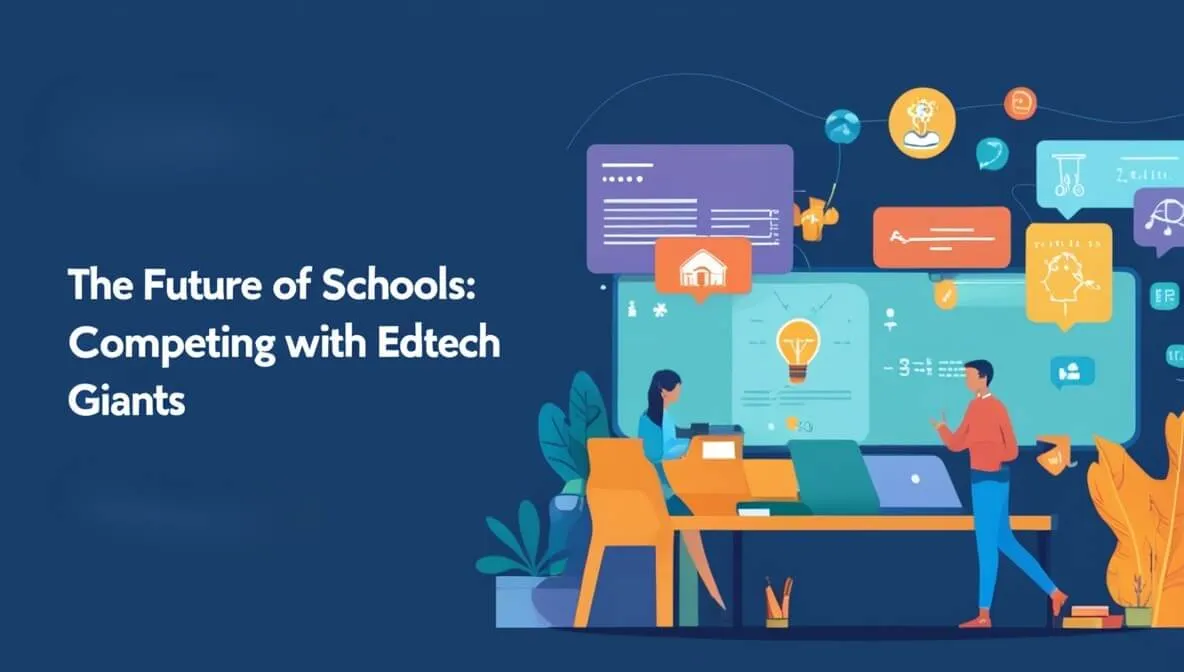Table of Contents
- Introduction
- Quick roadmap: How schools can compete with edtech giants (at a glance)
- 1. Reframe the question: compete, collaborate, or complement?
- 2. Strategy 1 — Put teachers at the center of digital transformation
- 3. Strategy 2 — Design student-centered blended learning programs
- 4. Strategy 3 — Build a results-first procurement and pilot process
- 5. Strategy 4 — Use data ethically and transparently
- 6. Strategy 5 — Cultivate a modular digital backbone (interoperability)
- 7. Strategy 6 — Offer what EdTech can’t: relationships, mentorship, and community
- 8. Case examples and evidence (what success looks like)
- 9. Roadmap: 12-month plan for school leaders who ask how schools can compete with edtech giants
- 10. Budget hacks: high impact, low cost moves
- Comparison: Schools vs EdTech Giants
- Implementation checklist
- FAQs
- How can schools compete with EdTech giants if they lack budgets?
- Can partnerships with EdTech vendors help schools compete with EdTech giants ?
- What role does data-driven personalization play in how schools can compete with edtech giants ?
- How fast can a school implement a digital transformation in education?
- Which LSI strategies work best for schools adopting EdTech?
- Conclusion
- Call to action
Introduction
The education landscape is changing fast. EdTech giants are scaling quickly, offering adaptive platforms, rich analytics, and polished user experiences. Many school leaders feel squeezed: budgets are tight, expectations are high, and parents demand modern learning. This raises one urgent question: how schools can compete with edtech giants and remain indispensable to their communities?
This post answers that question with a clear problem-solution arc. Pain point: schools risk losing relevance and students to slick platforms if they don’t adapt. Solution: a practical, step-by-step roadmap that blends technology, pedagogy, governance, and measurement. Throughout, we use proven tactics in digital transformation in education and real-world examples to show what works.
Why this matters now
EdTech growth, AI-driven personalization, and hybrid learning models are shifting how families choose learning experiences. School leaders who ask how schools can compete with edtech giants and take deliberate action will protect enrollment, improve learning outcomes, and reclaim strategic control over the learning journey.
Quick roadmap: How schools can compete with edtech giants (at a glance)
- Clarify mission and measurable outcomes.
- Invest in teacher-led blended learning, not tech for tech’s sake.
- Build data and analytics capability to personalize instruction.
- Create proof-of-impact pilots and scale what works.
- Partner selectively with EdTech vendors — negotiate for privacy, interoperability, and co-development.
- Communicate wins to families and stakeholders with clear evidence.
1. Reframe the question: compete, collaborate, or complement?
Many school leaders view EdTech companies as purely competitors. That narrow frame misses opportunities. The smarter question is how schools can compete with edtech giants where necessary, collaborate where useful, and complement where they have unique advantages.
Schools’ unique advantages
- Deep, local relationships with families and communities.
- Skilled educators who understand learners’ social-emotional contexts.
- Physical spaces and routines that support belonging and social learning.
EdTech strengths
- Rapid product development and user experience design.
- Scalable adaptive content and analytics.
- Capital and distribution networks.
The strategy is hybrid: preserve human-centered strengths while adopting scalable technologies that amplify teaching.
2. Strategy 1 — Put teachers at the center of digital transformation
If you ask how schools can compete with edtech giants , start by investing in teacher capacity. Technology without teacher buy-in is wasted budget.
Key actions
- Professional development focused on blended learning design, formative assessment, and using analytics to inform instruction.
- Create digital coaching roles: instructional technologists who free teachers to focus on pedagogy.
- Allocate planning time so teachers can redesign lessons for blended formats.
Quick wins
- Run a 6-week blended learning sprint with measurable learning targets.
- Use existing free or low-cost platforms for formative assessment instead of buying large systems immediately.
3. Strategy 2 — Design student-centered blended learning programs
Blended learning is where school systems can beat EdTech vendors. Why? Schools can combine in-person mentoring and social learning with adaptive digital practice to deliver both personalization and human care.
Design principles
- Personalization anchored in teacher judgment, not left solely to algorithms.
- Clear routines: When do students use tech? When do they meet a teacher? Why?
- Data-informed grouping and targeted interventions.
Example model
- Morning: whole-class engagement and project kickoff.
- Midday: small-group coaching and intentional use of adaptive software for practice.
- Afternoon: reflection, social-emotional check-ins, and blended projects.
4. Strategy 3 — Build a results-first procurement and pilot process
Procurement often rewards shiny demos rather than measurable impact. To answer how schools can compete with edtech giants, shift procurement to a pilot-first, evidence-driven model.
Procurement checklist
- Start with learning goals and metrics before evaluating vendors.
- Run short pilots (8–12 weeks) with control and intervention groups where possible.
- Require interoperability and data portability in contracts.
- Negotiate for training, outcomes reporting, and clear renewal terms.
Example pilot metrics table
| Metric | Why it matters | Target (8–12 weeks) |
|---|---|---|
| % students meeting benchmark | Learning gain focus | +10 percentage points |
| Teacher usage & satisfaction | Adoption predictor | 80% engagement |
| Time-on-task with purpose | Implementation fidelity | 30–40 minutes/day |
5. Strategy 4 — Use data ethically and transparently
Data is where many EdTech firms shine. Schools can match and surpass them by using data ethically, linking insights to teacher practice, and being transparent with families.
Principles
- Limit data collection to what directly supports learning or safety.
- Share clear dashboards with teachers and families.
- Protect student privacy; insist on vendor compliance with local laws and policies.
Practical steps
- Start with a simple teacher dashboard showing formative progress and suggested interventions.
- Train teachers to interpret analytics and translate them into lesson changes.
6. Strategy 5 — Cultivate a modular digital backbone (interoperability)
EdTech giants lock users into ecosystems. Schools should build a modular backbone that allows best-of-breed tools to plug in and be swapped out without disrupting teaching.
Technical priorities
- Choose standards-based tools (LTI, IMS, OneRoster where applicable).
- Centralize identity and rostering to simplify access management.
- Maintain a small catalogue of vetted apps with clear pedagogical use cases.
7. Strategy 6 — Offer what EdTech can’t: relationships, mentorship, and community
EdTech companies scale content. Schools scale relationships. That human advantage matters for learning, equity, and community trust.
Practical tactics
- Expand mentorship programs and advisory periods.
- Use project-based learning to connect students with local partners.
- Leverage alumni and community experts to enrich digital resources.
8. Case examples and evidence (what success looks like)
Illustrative examples (anonymized or public programs) show how blended approaches lead to strong gains. Use local pilots and public evidence to build credibility.
What to measure
- Academic gains (standardized or benchmark growth).
- Engagement metrics (attendance, time-on-task, course completion).
- Parent and teacher satisfaction.
9. Roadmap: 12-month plan for school leaders who ask how schools can compete with edtech giants
Months 1–3: Discovery and vision
- Audit current tech, pedagogy, and staff readiness.
- Set three measurable learning goals for the year.
- Launch a stakeholder communication plan.
Months 4–6: Pilot and capacity building
- Run 2 pilot classrooms for blended learning models.
- Train a core cohort of teachers and assign digital coaches.
- Build dashboards and data flows.
Months 7–9: Evaluation and scale
- Analyze pilot data against targets.
- Share results with families and staff; iterate.
- Expand to a grade band or subject area.
Months 10–12: Institutionalize
- Update procurement policies and deploy tested tools.
- Embed professional development into the school calendar.
- Publish an annual evidence report for stakeholders.
10. Budget hacks: high impact, low cost moves
- Prioritize PD and coaching over a single big platform purchase.
- Use free/low-cost formative tools during pilots.
- Reallocate existing tech budget toward interoperability and training.

Comparison: Schools vs EdTech Giants
| Area | School advantage | EdTech advantage | Action for schools |
| Personalization | Contextual, teacher-led personalization | Algorithmic adaptive content at scale | Combine both: teachers use analytics to tune adaptive paths |
| Trust & community | Strong local trust | Brand reach and polish | Use community trust to test and adopt tech with buy-in |
| Speed of change | Slower procurement | Rapid product cycles | Pilot quickly, then negotiate favorable terms |
| Cost model | Fixed budgets | VC-backed scaling | Focus on low-cost pilots and evidence for ROI |
Implementation checklist
- Declare measurable learning goals.
- Appoint an instructional technologist or digital lead.
- Run at least one 8–12 week pilot with clear metrics.
- Publish pilot results to stakeholders.
- Enforce data privacy and interoperability criteria in contracts.
FAQs
How can schools compete with EdTech giants if they lack budgets?
Start with low-cost, high-impact moves: teacher PD for blended learning, targeted pilots with free formative tools, and reallocating budgets to coaching and interoperability. The focus should be on measurable learning gains rather than buying the biggest platform.
Can partnerships with EdTech vendors help schools compete with EdTech giants ?
Yes—strategic partnerships that include co-development, training, and data rights can accelerate impact. Negotiate terms for data portability, privacy, and clear outcomes.
What role does data-driven personalization play in how schools can compete with edtech giants ?
Data-driven personalization is central. However, schools should ensure personalization is teacher-anchored, ethically governed, and aligned to measurable learning goals.
How fast can a school implement a digital transformation in education?
Meaningful change happens in cycles. A practical 12-month roadmap can produce pilot evidence and early scale. Focus on short pilots (8–12 weeks) and iterative improvement.
Which LSI strategies work best for schools adopting EdTech?
LSI strategies such as blended learning, personalized learning, interoperability, and instructional coaching all contribute. Combine them into a coherent digital strategy.
Conclusion
The question of how schools can compete with edtech giants is not an either/or choice. Schools win when they blend human strengths with thoughtful, evidence-driven technology. Start small, measure impact, and scale with rigor. Schools that do this will maintain their central role in communities and deliver improved outcomes for learners.
Call to action
If your school or institute is ready to move from anxiety to action, legacyedtech.in can help you design pilot programs, set measurable goals, and negotiate vendor agreements. Adopt a results-first approach to digital transformation in education and protect your school’s future—start a pilot this term.







